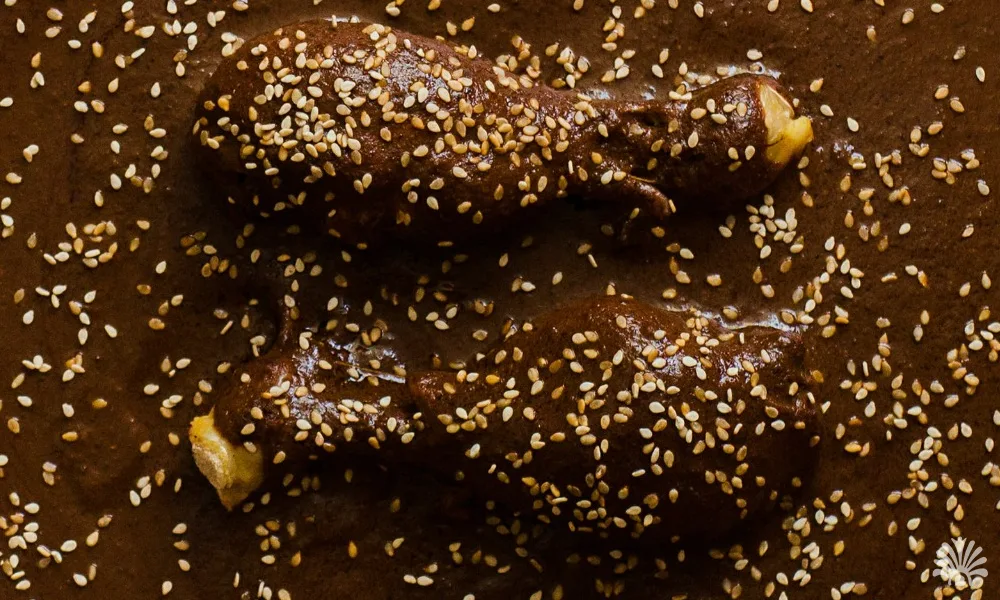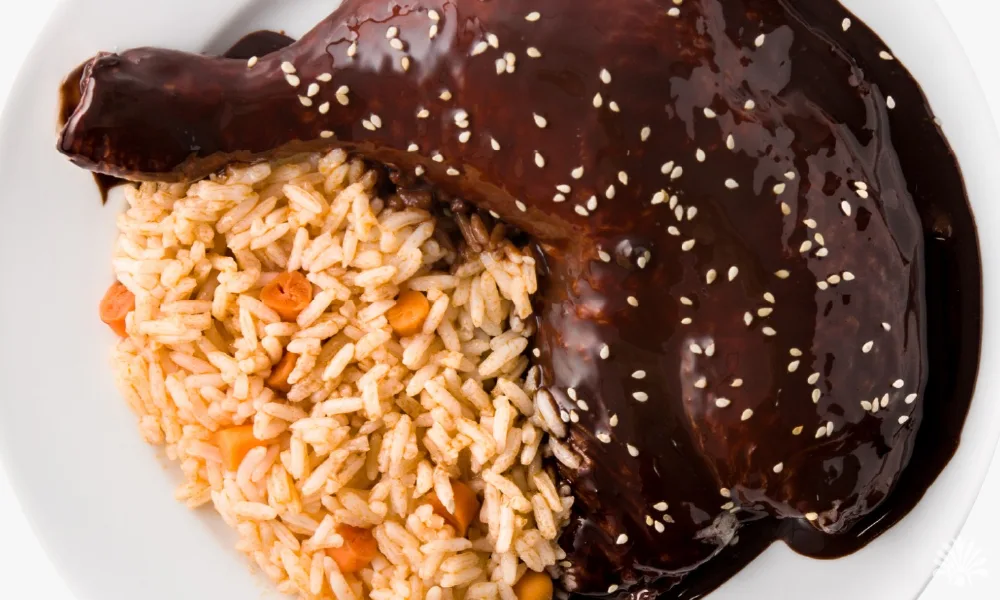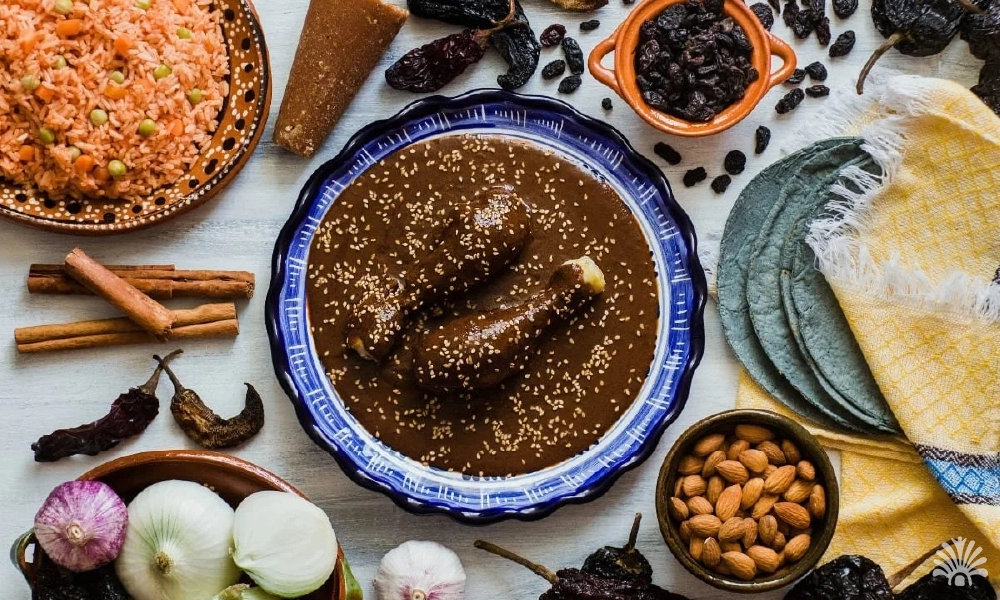|
Getting your Trinity Audio player ready...
|
Mexico is a land of mystery, music, and mole. Mole, a signature dish in Mexican cuisine, often sparks curiosity and confusion among those new to the country’s rich culinary traditions. Many ask, “Mole? Isn’t that the chocolate sauce? I don’t think I’d like chocolate in my sauce.” If this sounds like you, read on. You might be intrigued enough to try mole with your next Mexican meal!
by Claudia Velo
Did you know that the word “mole” literally means “sauce” in Nahuatl, the language of the Aztecs? That’s where “guacamole” also comes from: “aguacatl” is the Aztec word for avocado, so guacamole means avocado sauce. And that wraps up today’s fun fact!
Is Mole Made with Chocolate?
It’s a common misconception that mole is simply a chocolate sauce. While chocolate is an ingredient in one type of mole called Mole Poblano—from Puebla, a region outside of Mexico City—mole is more like a richly flavored, moderately hot curry. The use of chocolate adds depth, but it’s not the dominant flavor in most moles.
A Symphony of Ingredients in Mole
What makes mole truly extraordinary is its intricate mix of ingredients. The base typically includes a combination of dried chiles, nuts, seeds, and spices. Common ingredients are almonds, peanuts, sesame seeds, and spices like cinnamon and cloves. While chocolate is sometimes added to provide a subtle sweetness, it’s the complexity of the dried chiles and spices that stands out.
Each region of Mexico adds its own twist to mole, creating variations that range from yellow and green, bright with fresh chiles and herbs, to many tones of orange and red. The rich brown and black hues of Mole Negro come from a mix of chiles, nuts, seeds, and a touch of chocolate.

Important Note for Allergies
If you have nut allergies, be cautious—traditional mole always includes some sort of nut. Additionally, those with gluten sensitivity should note that mole often contains bread, tortillas, or masa as thickening agents.
The History of Mole: A Blend of Cultures
Mole’s origins reflect the blend of indigenous and Spanish influences that shape Mexican culture. According to tradition, Mole Poblano was created by nuns in the Convent of Santa Rosa in Puebla. When faced with an unexpected visit from the archbishop, they mixed available ingredients to create the rich sauce we know today.
Pre-Hispanic culinary traditions also include a variety of moles that did not use many of the nuts and spices brought by the Spanish. This rich fusion of indigenous and Spanish elements has given us the mole we enjoy today, a perfect symbol of Mexican heritage and culinary artistry.
Where to Try Mole in Los Cabos
Whether you’re a food enthusiast or a casual traveler, trying mole is an essential part of any visit to Mexico. The dish embodies the essence of Mexican cuisine—rich, flavorful, and steeped in tradition. Each region offers its own twist, making mole a delightful adventure for your taste buds.
If you’re in Los Cabos, don’t miss out on these spots:
Torote: Known for its authentic Mole Poblano, this restaurant located in Valle del Sol offers a taste of Puebla right in the heart of Los Cabos.
La Carreta in El Merkado: For a unique treat, try the Mole Negro at this local favorite.
A Must-Try Mexican Delight
With its complex layers of flavors and rich history, mole is much more than just a sauce. It’s a symbol of Mexican heritage and a testament to the country’s culinary creativity. So next time you hear someone mention mole, you’ll know it’s worth trying—and perhaps you’ll become a fan of this incredible Mexican treasure.
Planning Your Culinary Adventure in Los Cabos?
Don’t miss the chance to try these incredible mole dishes at Torote en Valle del Sol and La Carreta in El Merkado. Your taste buds will thank you for this flavorful journey through Mexican cuisine. Book your table today and enjoy the best of Los Cabos culinary delights!

About the Author
Claudia Velo is the proud winner of the first-ever Food Critic award from Los Cabos Culinary Awards. Claudia lives life one delicious bite at a time. For her, food is the best representation of unconditional love, and cooking for others is the ultimate act of kindness. She is constantly searching for new experiences and moments to savor at tables where stories and flavors create indelible memories. Her reviews are honest opinions that aim to encourage others to explore the pleasures of enjoying food, beyond the search for mere sustenance.
Claudia’s favorite quote is: “Nothing would be more tiresome than eating and drinking if God had not made them a pleasure as well as a necessity.” – Voltaire
Follow Claudia:
Webstite: claudiavelo.com
Instagram: @c_velo
Facebook: Claudia Velo
